
Hiking is a phenomenal way to get outside and take advantage of all nature has to offer that benefits both your mind and body. Any experienced hiker will tell you that having the right gear can make or break your hiking adventure. Perhaps the most critical piece of hiking clothing you need is a reliable pair of hiking boots. If your feet are happy, your hike becomes infinitely better.
When it comes to hiking boots, it's not just about how the shoe looks or fits. There are technical specifications that need to be considered in order to navigate varied landscapes and weather. Sure, you want to look at the typical things like fit, comfort, and style. But analyzing specs such as traction, durability, material, and waterproofness is critical with hiking boots.
Are you bundling up to tackle your next trail in the dead of winter? Or do you plan to grind your way through a hike on rocky terrain? With so many technical specs to consider and trails to explore, how do you know what boot is the right one for you? Well, you are in the right place to start that search. In this article, the ACTIVE Reviews Team offers a comprehensive guide on what to look for in a pair of hiking boots, as well as our top picks of the best hiking boots on the market today.
Read on, friends. Your next hiking adventure awaits.
Why Trust Us?
ACTIVE.com's editorial team relies on the knowledge and experience of fitness and wellness experts including competitive athletes, coaches, physical therapists, nutritionists, and certified trainers. This helps us ensure that the products we feature are of the highest standard. Collectively, the team has spent countless hours researching equipment, gear, and recovery tools in order to create the most accurate, authentic content for our readers. Customer satisfaction is also a key part of our review process, which is why we only feature products that are highly rated.
The Best Hiking Boots - Our Top Picks
By clicking on the product links in this article, we may receive a commission fee at no cost to you, the reader. Read the full affiliate disclosure here.
- Best Overall Hiking Boots: Cross Hike Mid Gore Tex (Men) Cross Hike Mid Gore Tex (Women)
- Best Lightweight Hiking Boots: Altra Lone Peak (Men) Altra Lone Peak (Women)
- Best Leather Hiking Boots: TPS 520 GV Evo (Men) TPS 520 GV Evo (Women)
- Best Hiking Boots for Plantar Fasciitis: X Ultra 3 Wide (Men) X Ultra 3 Wide (Women)
- Best Hiking Boots for Wide Feet: Nucleo High II (Men) Nucleo High II(Women)
- Best Budget Hiking Boots: Moab 2 Vent (Men) Moab 2 Vent (Women)
- Best Hiking Boots for Women: Aerios AR Mid GTX
- Best Hiking Boots for Men: Terrex Free Hiker XPL
- Best Beginner Hiking Boots: Lowa Renegade GTX Mid (Men)Lowa Renegade GTX Mid (Women)
How to Choose a Hiking Boot
We all have unique feet, which means there is no single best hiking boot. To find the best hiking boot for you, it's important to find a pair that combines both fit and function to maximize comfort. Durability, traction, sizing, and waterproofing are the main specs to consider.
Durability
The durability of a hiking boot is contingent on the material and planned usage. The most common materials used for hiking shoes are synthetic and leather. Of the two, leather is more durable and the better choice if you plan on hiking through rugged land, as synthetics are more easily damaged than leather—not something you want to worry about mid-hike.
Sizing
A pair of good-fitting boots is somewhat subjective and boils down to what feels comfortable. However, there are a few measurements used to determine the best size for you. Length from heel to toe, arch length, foot width, and volume (how much space your foot takes up) are the key measurements to have. You will find variability in sizing between manufacturers, so having your specific measurement will make finding a good fit easier. Ideally, hiking boots fit snugly everywhere but are not too tight.
Traction
Traction refers to a boot's resistance to slippage. Traction comes from tread patterns which differ between manufacturers. Known as lug patterns, the design of the bumps on the outsole of a boot is intended for different types of terrain. Deep, thick, and widely spaced lugs are used to improve grip and are best suited for muddy trails or technical hikes.
Heel brakes aren't found on every boot but do provide an extra level of protection against sliding. It is the heel zone that is separate from both the arch and forefoot made to prevent sliding. If you plan on hitting some steep trails or unstable terrain, a heel brake will come in very useful.
Waterproofing
Don't let the weather get in the way of your next hike. Instead, snag a pair of waterproof boots. There is a catch, though—most waterproof boots have reduced breathability which means they may cause you to sweat more on warm days.
Types of Hiking Boots
Hiking boots fall into one of three categories: lightweight, midweight, and heavyweight. This is determined by a boot's weight, ankle stability, and support provided. Each type lends itself better to different styles of hiking.
- Lightweight: Lightweight hiking boots are designed for shorter hikes on well-kept trails. Because of their lighter weight, they are a good choice on warmer days. However, with improvements in technology, all hiking boots are trending toward being more lightweight even when providing heftier protection.
- Midweight: Midweight boots are best for longer hikes carrying a heavier load. They are generally sturdier, weather-resistant, breathable, and can handle the weight of heavier backpacks.
- Heavyweight: Heavyweight hiking boots are engineered to withstand colder climates, difficult topography, or especially long hiking adventures. A boot that is too heavy won't be comfortable, so try on the boot and wear it around for a while before making your purchase.
Best Overall Hiking Boots - Cross Hike Mid Gore-Tex
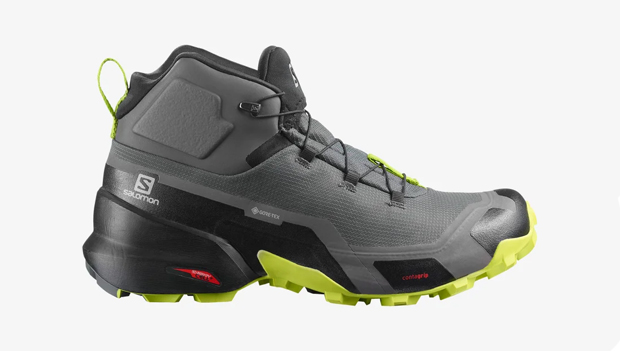
SPECS
- Type: Midweight
- Material: Textile and synthetic MCL upper, rubber outsole
- Weight: 396g
- Waterproof: GORE-TEX material
- Key features: OrthoLite insole, multi-directional lugs, heel brake, Quicklace lacing system
Topping off our list of the best overall hiking boots is the Cross Hike Mid Gore-Tex. This high-quality piece of footwear is engineered by Solomon, a brand that rarely disappoints when it comes to hiking shoes. Made in both men's and women's sizes, the Cross Hike Mid Gore-Tex provides hikers with a high level of foot protection in all weather conditions and neutral support and is suited to tackle both mixed and technical outdoor terrain.
Thanks to the Contagrip, an all-terrain outsole with multi-direction lugs, these boots will prevent slipping on muddy land. The ergonomic heel brake provides an extra layer of safety and stability on downhill trails. However, the neutral level of support may leave hikers wanting more stability while attacking rigorous terrain.
This mid-height boot is made with GORE-TEX and an anti-debris mesh with a rubber stone guard for ultimate waterproof protection. A responsive midsole provides cushioning and, combined with an OrthoLite sockliner insole that aligns with the curves of your foot, users appreciate its comfort. The Cross Hike Mid Gore-Tex boot features Quicklace, a one-pull tightening lacing system. Some users report that while it is easy to get the laces snug, they loosen during a hike.
What We Like
- Responsive midsole
- Cushioned
- Multi-directional lugs
- Easy lacing system
- Heel brake
- Budget-friendly
What We Don't Like
- Neutral support
- Quicklace system may loosen over time
- Traction on wet rock is questionable
BUY: Cross Hike Mid Gore Tex (Men), Cross Hike Mid Gore Tex (Women)
Best Lightweight Hiking Boots - Altra Lone Peak
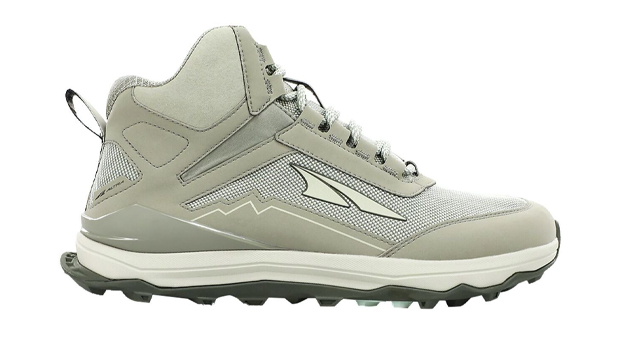
SPECS
- Type: Lightweight
- Material: Mesh upper with polyurethane overlays, Altra Ego midsole, DuraTread sole
- Weight: 326g (Men), 281g (Women)
- Waterproof: No
- Key features: Zero-drop sole, midsole Altra Ego foam
You will be hard pressed to find a hiking boot as lightweight and comfortable as the Altra Lone Peak Hiking Boot. They combine cushioning and flexibility with mid-cuff stability and ultra-grippy Duratread soles for maximum traction. The result is a pair of hiking boots that can tackle both technical and everyday trails.
What makes this shoe stand out is the foot shape, a feature unique to Altra. It is ergonomically designed to provide more space in the toe box allowing for natural stretching and splaying of the toes. Altra Lone Peak Hiking Boots provide a balanced cushioning along the foot for a zero-drop sole which may be attractive to some, but a deal-breaker for those who dislike zero-drop shoes.
Constructed with a breathable mesh upper and reinforced with durable polyurethane, these boots are breathable. Unfortunately, they won't help much in wet weather as the material is not waterproof.
What We Like
- Ergonomic foot shape
- Balanced cushioning
- Responsive midsole foam
- Very lightweight
- Comfortable
What We Don't Like
- Not waterproof
- Not everyone likes zero-drop shoes
BUY: Altra Lone Peak (Men), Altra Lone Peak (Women)
Best Leather Hiking Boots - Asolo TPS 520 GV Evo

SPECS
- Type: Lightweight
- Material: Water-resistant full grain leather upper, GORE-TEX performance comfort lining, Vibram Triple Power Structure sole
- Weight: 1 lb. (Men), 9.4 oz. (Women)
- Waterproof: Water-resistant leather and GORE-TEX Performance Comfort lining
- Key features: Dual-density polyurethane midsole, lifetime warranty, metal eyelets
Durable, rugged, comfortable, and functional, the TPS 520 GV Evo takes the top spot for best leather hiking boots. Thanks to a thick, full-grain leather upper, GORE-TEX Performance Comfort lining, and metal eyelets, these kicks will protect your feet in all weather conditions for miles to come. Their dual-density midsole is stiff, providing good stability on unsteady ground, but agile enough to feel comfortable.
The ankle shaft is padded and contoured to keep out debris. While leather can sometimes carry a long break-in period, that is not the case with the TPS 520 GV Evo; users rave about their comfort right out of the box. And with a snug lacing system, you can adjust the tightness for maximum comfort. Credit the Virban Tiple Power Structure sole for top-of-the-line traction in any terrain.
What We Like
- Abrasion-resistant leather upper
- GORE-TEX liner
- Grippy sole
- Durable
- Lightweight
What We Don't Like
- Limited sizing available
- Expensive
BUY: TPS 520 GV Evo (Men), TPS 520 GV Evo (Women)
Best Hiking Boots for Plantar Fasciitis - X Ultra 3 Wide
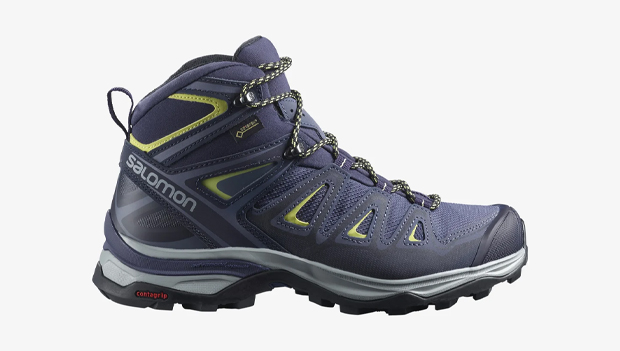
SPECS
- Type: Midweight
- Material: Leather/textile MCL upper, rubber outsole, GORE-TEX
- Weight: 450g (Men), 410g (Women)
- Waterproof: GORE-TEX and water repellent treated
- Key features: Chevron lugs, 11mm heel-to-toe drop, gusseted tongue, Advanced Chassis molded insert, OrthoLite sockliner, EVA foam, Mud Contagrip
Dealing with Plantar Fasciitis is a real bummer on just a day-to-day basis let alone for anyone who loves hiking. If you don't want to let this injury get in the way of your next hike, you'll want to consider snagging a pair of X Ultra 3 Wide hiking boots designed with the heel and arch cushioning and support you need. Featuring an Advanced Chassis molded insert actually embedded in the outsole and an OrthoLite sockliner, the X Ultra 3 stabilizes your heel while providing lateral support and cushion to keep your foot stable at all times.
The X Ultra 3 Wide is as functional as it is supportive. In addition to the anti-debris tight mesh upper, there is a gusseted tongue connected to both sides of the upper to fend off debris. Two different types of rubber are used on the sole, with chevron lugs to provide maximum traction. And, with a protective mudguard, you can wear these on both rocky and muddy trails.
Solomon did not cut corners when it came to waterproofing—GORE-TEX material keeps your feet dry and the upper fabric is treated with a water repellent. A protective rubber covers the majority of the front of the foot and the leather is coated with polyurethane to keep the X Ultra 3 in good condition for a long time to come.
What We Like
- Good traction
- Ample cushioning and support
- Durable
- Protective mudguard
- Affordable
What We Don't Like
- Lower ankle shaft height
- Sizes sell out quickly
BUY: X Ultra 3 Wide (Men), X Ultra 3 Wide (Women)
Best Hiking Boots for Wide Feet - Nucleo High II
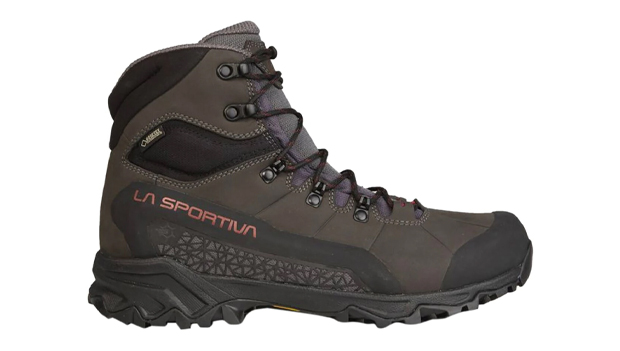
SPECS
- Type: Lightweight
- Material: Nubuck leather with Nano-cell inserts, GORE-TEX, Vibram outsole, molded EVA midsole
- Weight: 17.6 oz. (Men), 16.8 oz. (Women)
- Waterproof: GORE-TEX surround
- Key features: OrthoLite liner, Nano inserts
Any hiker with particularly wide feet may enjoy La Sportiva Nucleo High II GTX Boot, a heavy-duty boot with a lighter weight. The wider design accommodates feet that may otherwise feel constricted. They feature GORE-TEX Surround technology, protecting your feet from water, wind, and debris.
Compression-molded EVA in the midsole coupled with a unique Impact Brake System allows you to feel comfortable yet secure and safe on any terrain. The insole has decent cushioning, however, some users find the upper unforgiving. But it is this stiffness from the Nubuck leather upper that provides the stability, something you want in a hiking shoe intended for challenging trails.
What We Like
- Good for wide feet
- Waterproof
- Solid traction
- High lacing system
What We Don't Like
- May feel stiff
BUY: Nucleo High II (Men), Nucleo High II (Women)
Best Budget Hiking Boots - Merrill Moab 2 Vent
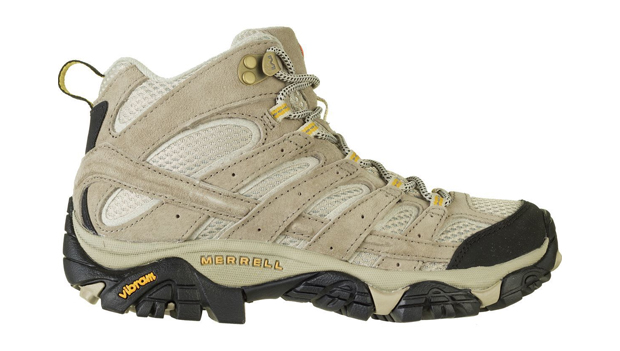
SPECS
- Type: Midweight
- Material: Suede, mesh, and rubber upper, Vibram TC5+ sole
- Weight: 2 lbs. 2 oz. (Men), 1 lb. 14 oz. (Women)
- Waterproof: Suede upper is waterproof
- Key features: Merrill Air Cushion, Speed Band, EVA footbed, mesh inserts
The Moab 2 Vent can put to bed the notion that budget-friendly means poorer quality. These classic hiking boots provide the features you need for any hike at an affordable price. The suede upper is both waterproof and durable while mesh inserts maintain a good level of breathability. In addition, there is a protective toe cap to keep your feet safe from rougher land. The outsole is made with Vibram TC5 and five-millimeter lugs for solid traction on any surface.
These hiking boots are very supportive. The footbed is made with zonal arch and heel support with Merrill's patented Merrill Air Cushion for shock absorption. The shoe also has a Speed Band for torsional support which prevents excessive twisting mid-foot. As a result, the muscles in this area can focus on the mechanics of walking.
What We Like
- Price
- Stability
- Arch, heel, and torsional support
- Breathability
What We Don't Like
- They tend to run small
- Some reviewers felt the sole didn't have enough cushioning
BUY: Moab 2 Vent (Men), Moab 2 Vent (Women)
Best Hiking Boots for Women - Aerios AR Mid GTX

SPECS
- Type: Lightweight
- Material: 100% PFC-free woven polyester, Vibram XS Trek outsole
- Weight: 480g
- Waterproof: GORE-TEX membrane
- Key features: 3D-Ultralon pre-shaped ankle and tongue foam, cushioned with 100% recycled EVA, waterproof, TPU midfoot, mud-shedding aggressive lug pattern
For any woman wanting to lace up with a pair of stylish, durable, and functional hiking boots (or hiking shoes) that can stand up on the roughest terrain, the Aerios AR Mid GTX is a solid choice. These boots offer a lot of stability and support without adding much weight. Their versatile design means they can be worn for multiple activities. The combination of an aggressive lug pattern and sticky outsole results in a boot with impressive traction
The Aerios AR features a 3D-molded Ultralon collar designed to allow for ankle movement while also bracing and supporting it. Constructed with GORE-TEX, these boots are completely waterproof and, according to some users, keep your feet dry even when wading through deep water. As with most waterproof boots, breathability is sacrificed as the two don't often go hand in hand. However, users do report that the breathability is adequate enough for warmer hikes. Equipped with EVA midsoles and a lace locking system, these boots are as comfortable as they are practical.
What We Like
- Lightweight
- Stable
- EVA injected cushioning
- Waterproof
- Rugged lug pattern
- Modern design
What We Don't Like
- Expensive
- Limited sizing
BUY: Aerios AR Mid GTX
Best Hiking Boots for Men - Terrex Free Hiker XPL
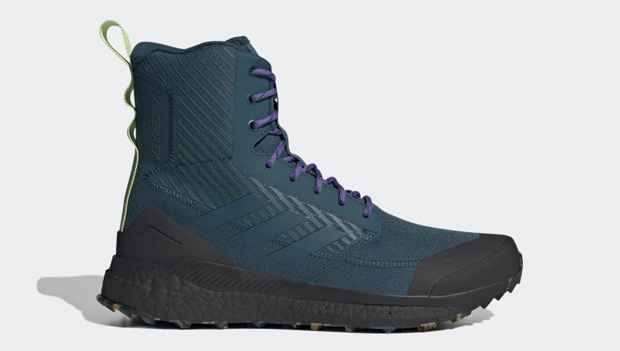
SPECS
- Type: Lightweight
- Material: Canvas upper, Continental rubber outsoles
- Weight: Not listed
- Waterproof: Water-repellent treated
- Key features: Energy return
Better known for their line of running shoes, Adidas hit a home run with the release of the Terrex Free Hiker XPL for men. Comfort meets support in the uniquely designed Terrex Free Hiker CPL which features Adidas' popular BOOST cushioning for good energy return. Combined with a supportive canvas upper, they have just the right balance of security and cushioning. These boots sit high around the ankle for maximum support, but users report their lightweight design and overall comfort make you forget you are even wearing a high-cut boot.
The abrasion-resistant canvas upper is composed of 50 percent recycled polyester. There is a molded toe cap and heel section for added reinforcement and stability. The overall feel of these boots is snug but not restrictive, with high lacing that enables you to tailor the fit.
The upper is water-repellent treated but not specifically made with a waterproof material, which is less than ideal for hikes in wet weather. On the other hand, the canvas provides maximum breathability so they are a solid option for warmer days. Regardless of the weather, the Continental Rubber grip is one of the best you will come across, providing exceptional traction in all conditions.
What We Like
- Continental rubber outsole
- Sock-like fit
- BOOST midsole cushioning
- Breathable
- Abrasion resistant
What We Don't Like
- Not waterproof
- Expensive
- Sizes sell out quickly
Best Beginner Hiking Boots - Lowa Renegade GTX Mid
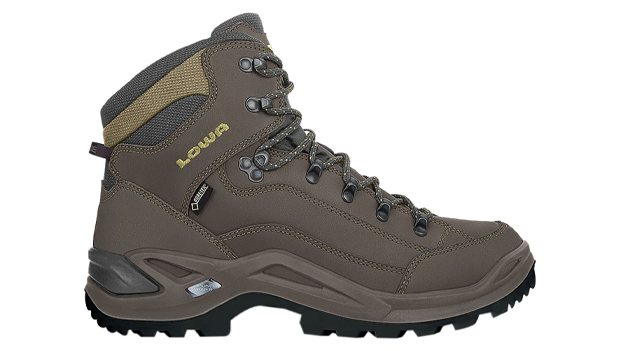
SPECS
- Type: Midweight
- Material: Heinen Terracare Nubuck upper (women), Full-grain Cordura Nubuck (men), double-injection DuraPU midsole, Vibram Evo sole
- Weight: 1 lb. 3.6 oz. (men), 1 lb. 2 oz. (women)
- Waterproof: GORE-TEX membrane
- Key features: Climate Control System, cushioned footbed, speed hook laces
If you are new to hiking, you want a boot that offers a variety of features. This way, you can focus on your new trekking adventure without being distracted with poor footwear. The Renegade GTX Mid Hiking Boot provides all the specs a beginner would need in a high-quality boot. These leather hiking boots are equipped with a Monowrap, which provides a lightweight and supportive frame.
Combining comfort with function, the Renegade GTX boots are waterproof with a GORE-TEX membrane, yet has a Climate Control System that enables ample airflow. Ready for any terrain, they are equipped with Vibram Evo outsole and a tread pattern that can handle everything from unstable rocky ground to snow. While the price may be overwhelming to some, these shoes are packed with all the specs a beginner needs to fall in love with hiking.
Something to note—there is a difference in the material used between men's and women's uppers; the men's feature a full-grain Cordura upper and the women's a Heinen Terracare Nubuck.
What We Like
- Comfortable
- Ample cushioning
- Stable
- Waterproof
- Breathable
- Grippy tread
- Stiff midsole
What We Don't Like
- Expensive
- Not ideal for warm weather
BUY: Renegade GTX Mid (Men), Renegade GTX Mid (Women)
FAQs About Hiking Boots
What is the difference between hiking boots and backpacking boots?
The difference between the two types of boots lies in their ability to support long-distance hiking carrying heaving loads. Hiking boots are generally used for day hikes that are shorter in duration, whereas backpacking boots are heavier and designed for multi-day, long-distance hikes.
What are the three types of hiking boots?
Hiking boots are categorized into three main types: lightweight, midweight, and heavyweight.
Should hiking boots be snug?
Yes, hiking boots should be snug. The rule of thumb is that they should feel snug everywhere but not tight anywhere. Your foot should feel secure in a way that prevents it from moving around the boot. Your heel should be locked in place and your toes should not hit the front of the boot. But, there should not be much extra space surrounding your foot.
Why are hiking boots better than sneakers?
Sneakers and hiking boots serve very different purposes. Sneakers are great for daily wear, walking, and running, but hiking boots are better than sneakers when it comes to hiking. They provide more stability, and protection, and are made with material designed to withstand variable climates.
How long do hiking boots last?
Most hiking boots are engineered to last for 350 to 500 miles of use. For avid hikers, this may mean replacing boots every 3-6 months, but most recreational hikers may get a few years' worth of wear.
Should you buy hiking shoes a size bigger?
Many experienced hikers recommend sizing up one-half to a full size bigger than your normal shoe size. But sizing varies between manufacturers, so your best bet for a good fit is taking measurements of your feet.
Should you wear two pairs of socks when hiking?
Whether or not you should wear two pairs of socks when hiking is dependent on the weather and boot style. On excessively cold days, doubling up on socks may be necessary whereas, on a blistering hot day, two pairs of socks will just cause excessive sweating.


